Corporate Accounting and Reporting pdf
VerifiedAdded on 2021/06/17
|8
|1426
|22
AI Summary
Contribute Materials
Your contribution can guide someone’s learning journey. Share your
documents today.
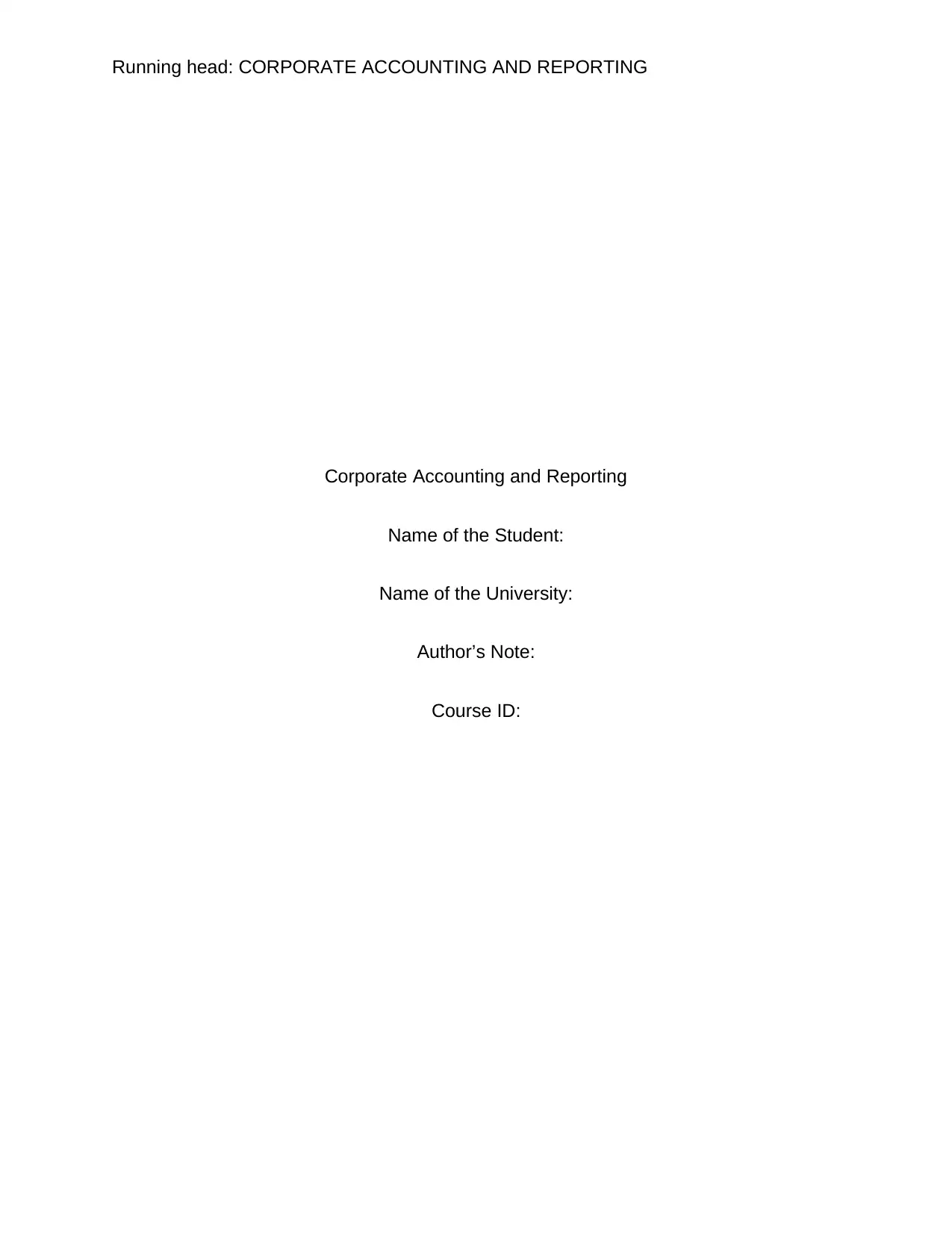
Running head: CORPORATE ACCOUNTING AND REPORTING
Corporate Accounting and Reporting
Name of the Student:
Name of the University:
Author’s Note:
Course ID:
Corporate Accounting and Reporting
Name of the Student:
Name of the University:
Author’s Note:
Course ID:
Secure Best Marks with AI Grader
Need help grading? Try our AI Grader for instant feedback on your assignments.
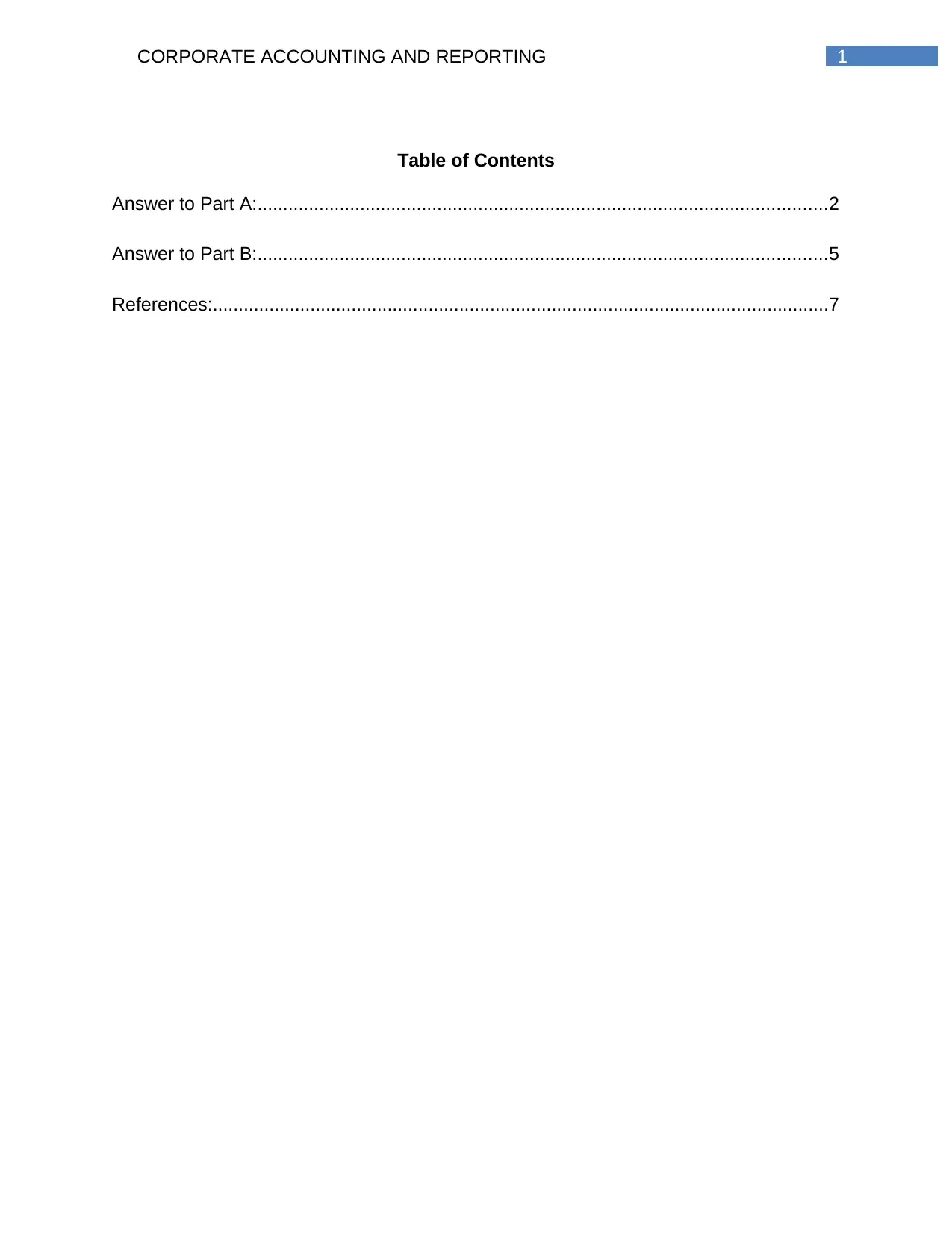
1CORPORATE ACCOUNTING AND REPORTING
Table of Contents
Answer to Part A:...............................................................................................................2
Answer to Part B:...............................................................................................................5
References:........................................................................................................................7
Table of Contents
Answer to Part A:...............................................................................................................2
Answer to Part B:...............................................................................................................5
References:........................................................................................................................7
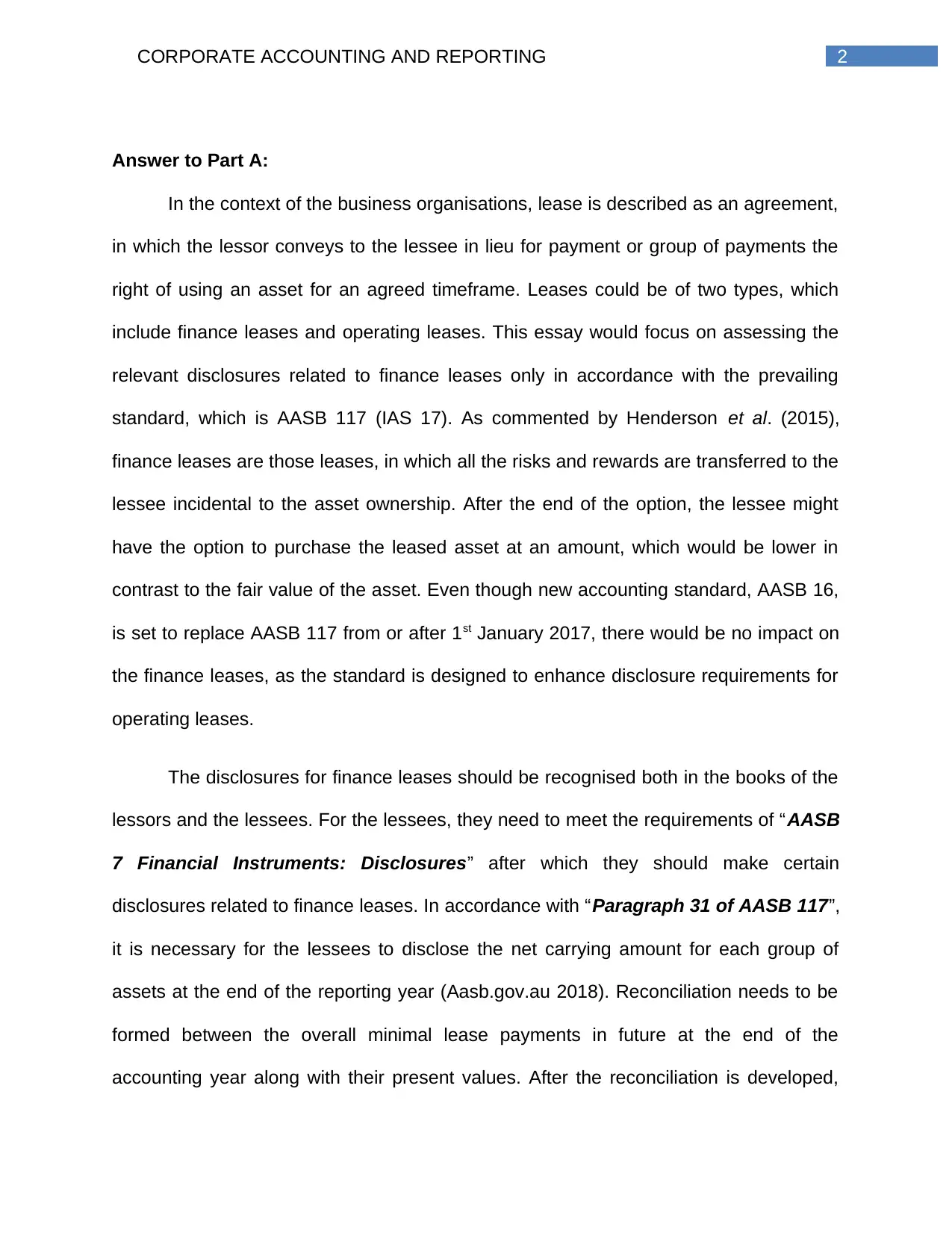
2CORPORATE ACCOUNTING AND REPORTING
Answer to Part A:
In the context of the business organisations, lease is described as an agreement,
in which the lessor conveys to the lessee in lieu for payment or group of payments the
right of using an asset for an agreed timeframe. Leases could be of two types, which
include finance leases and operating leases. This essay would focus on assessing the
relevant disclosures related to finance leases only in accordance with the prevailing
standard, which is AASB 117 (IAS 17). As commented by Henderson et al. (2015),
finance leases are those leases, in which all the risks and rewards are transferred to the
lessee incidental to the asset ownership. After the end of the option, the lessee might
have the option to purchase the leased asset at an amount, which would be lower in
contrast to the fair value of the asset. Even though new accounting standard, AASB 16,
is set to replace AASB 117 from or after 1st January 2017, there would be no impact on
the finance leases, as the standard is designed to enhance disclosure requirements for
operating leases.
The disclosures for finance leases should be recognised both in the books of the
lessors and the lessees. For the lessees, they need to meet the requirements of “AASB
7 Financial Instruments: Disclosures” after which they should make certain
disclosures related to finance leases. In accordance with “Paragraph 31 of AASB 117”,
it is necessary for the lessees to disclose the net carrying amount for each group of
assets at the end of the reporting year (Aasb.gov.au 2018). Reconciliation needs to be
formed between the overall minimal lease payments in future at the end of the
accounting year along with their present values. After the reconciliation is developed,
Answer to Part A:
In the context of the business organisations, lease is described as an agreement,
in which the lessor conveys to the lessee in lieu for payment or group of payments the
right of using an asset for an agreed timeframe. Leases could be of two types, which
include finance leases and operating leases. This essay would focus on assessing the
relevant disclosures related to finance leases only in accordance with the prevailing
standard, which is AASB 117 (IAS 17). As commented by Henderson et al. (2015),
finance leases are those leases, in which all the risks and rewards are transferred to the
lessee incidental to the asset ownership. After the end of the option, the lessee might
have the option to purchase the leased asset at an amount, which would be lower in
contrast to the fair value of the asset. Even though new accounting standard, AASB 16,
is set to replace AASB 117 from or after 1st January 2017, there would be no impact on
the finance leases, as the standard is designed to enhance disclosure requirements for
operating leases.
The disclosures for finance leases should be recognised both in the books of the
lessors and the lessees. For the lessees, they need to meet the requirements of “AASB
7 Financial Instruments: Disclosures” after which they should make certain
disclosures related to finance leases. In accordance with “Paragraph 31 of AASB 117”,
it is necessary for the lessees to disclose the net carrying amount for each group of
assets at the end of the reporting year (Aasb.gov.au 2018). Reconciliation needs to be
formed between the overall minimal lease payments in future at the end of the
accounting year along with their present values. After the reconciliation is developed,
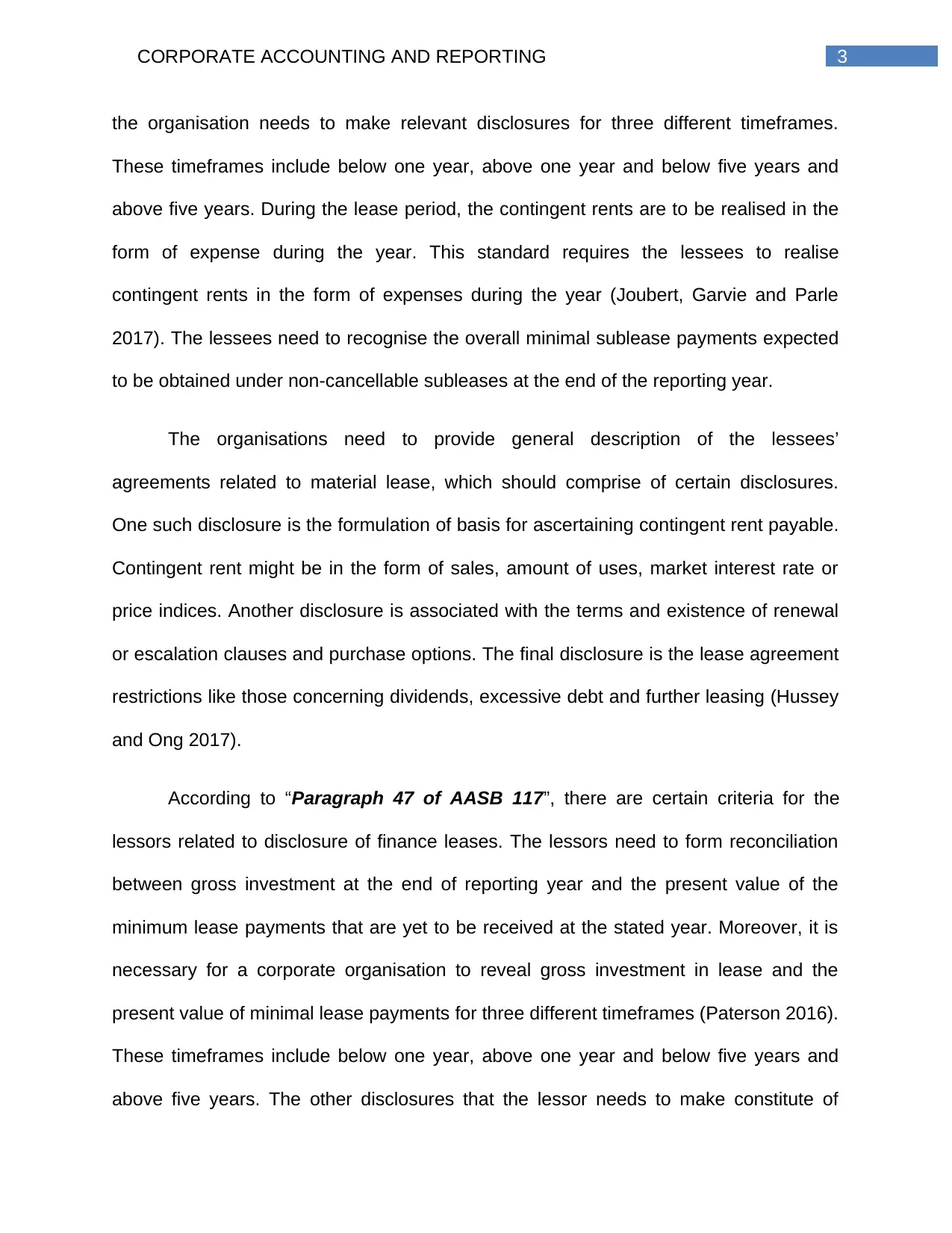
3CORPORATE ACCOUNTING AND REPORTING
the organisation needs to make relevant disclosures for three different timeframes.
These timeframes include below one year, above one year and below five years and
above five years. During the lease period, the contingent rents are to be realised in the
form of expense during the year. This standard requires the lessees to realise
contingent rents in the form of expenses during the year (Joubert, Garvie and Parle
2017). The lessees need to recognise the overall minimal sublease payments expected
to be obtained under non-cancellable subleases at the end of the reporting year.
The organisations need to provide general description of the lessees’
agreements related to material lease, which should comprise of certain disclosures.
One such disclosure is the formulation of basis for ascertaining contingent rent payable.
Contingent rent might be in the form of sales, amount of uses, market interest rate or
price indices. Another disclosure is associated with the terms and existence of renewal
or escalation clauses and purchase options. The final disclosure is the lease agreement
restrictions like those concerning dividends, excessive debt and further leasing (Hussey
and Ong 2017).
According to “Paragraph 47 of AASB 117”, there are certain criteria for the
lessors related to disclosure of finance leases. The lessors need to form reconciliation
between gross investment at the end of reporting year and the present value of the
minimum lease payments that are yet to be received at the stated year. Moreover, it is
necessary for a corporate organisation to reveal gross investment in lease and the
present value of minimal lease payments for three different timeframes (Paterson 2016).
These timeframes include below one year, above one year and below five years and
above five years. The other disclosures that the lessor needs to make constitute of
the organisation needs to make relevant disclosures for three different timeframes.
These timeframes include below one year, above one year and below five years and
above five years. During the lease period, the contingent rents are to be realised in the
form of expense during the year. This standard requires the lessees to realise
contingent rents in the form of expenses during the year (Joubert, Garvie and Parle
2017). The lessees need to recognise the overall minimal sublease payments expected
to be obtained under non-cancellable subleases at the end of the reporting year.
The organisations need to provide general description of the lessees’
agreements related to material lease, which should comprise of certain disclosures.
One such disclosure is the formulation of basis for ascertaining contingent rent payable.
Contingent rent might be in the form of sales, amount of uses, market interest rate or
price indices. Another disclosure is associated with the terms and existence of renewal
or escalation clauses and purchase options. The final disclosure is the lease agreement
restrictions like those concerning dividends, excessive debt and further leasing (Hussey
and Ong 2017).
According to “Paragraph 47 of AASB 117”, there are certain criteria for the
lessors related to disclosure of finance leases. The lessors need to form reconciliation
between gross investment at the end of reporting year and the present value of the
minimum lease payments that are yet to be received at the stated year. Moreover, it is
necessary for a corporate organisation to reveal gross investment in lease and the
present value of minimal lease payments for three different timeframes (Paterson 2016).
These timeframes include below one year, above one year and below five years and
above five years. The other disclosures that the lessor needs to make constitute of
Secure Best Marks with AI Grader
Need help grading? Try our AI Grader for instant feedback on your assignments.
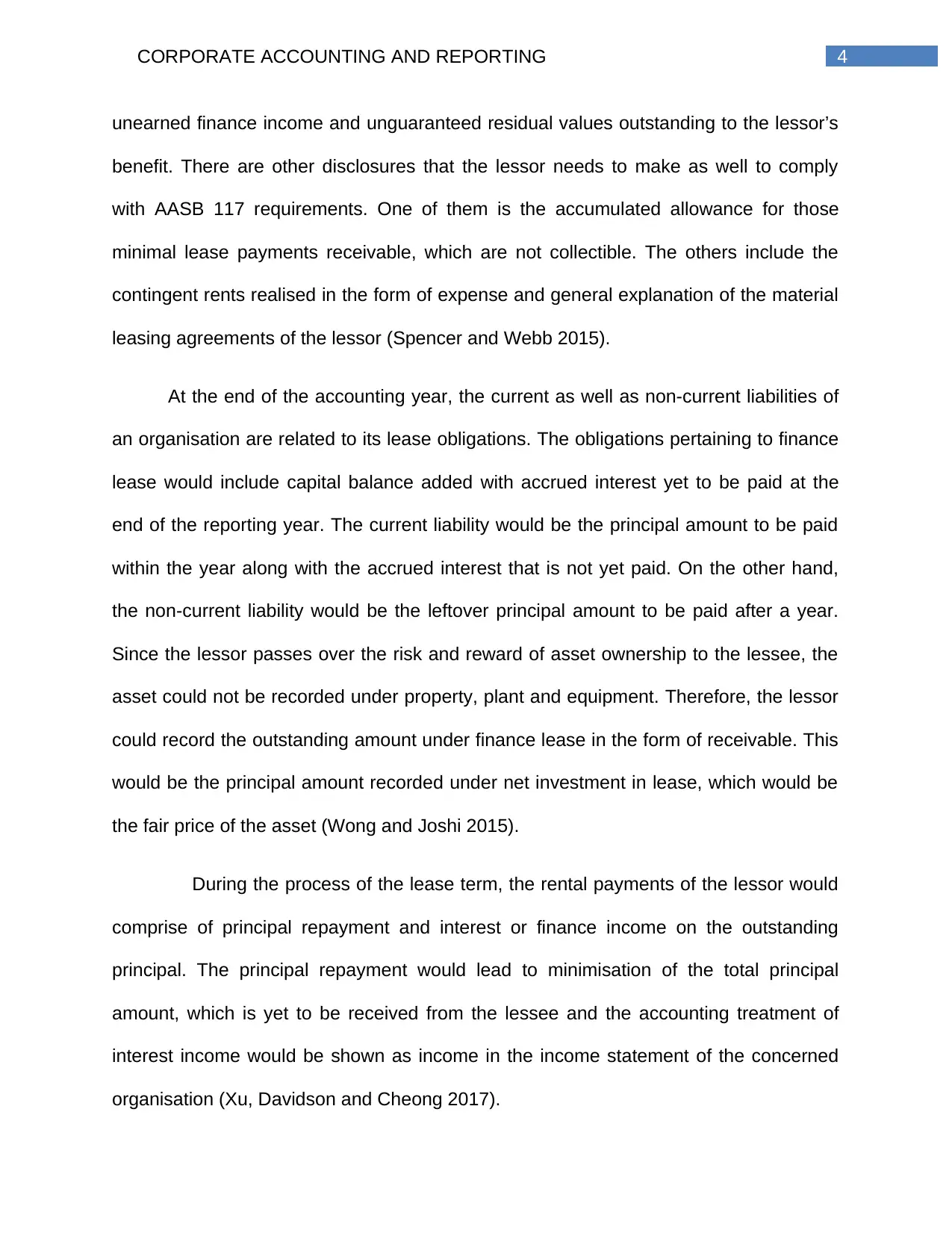
4CORPORATE ACCOUNTING AND REPORTING
unearned finance income and unguaranteed residual values outstanding to the lessor’s
benefit. There are other disclosures that the lessor needs to make as well to comply
with AASB 117 requirements. One of them is the accumulated allowance for those
minimal lease payments receivable, which are not collectible. The others include the
contingent rents realised in the form of expense and general explanation of the material
leasing agreements of the lessor (Spencer and Webb 2015).
At the end of the accounting year, the current as well as non-current liabilities of
an organisation are related to its lease obligations. The obligations pertaining to finance
lease would include capital balance added with accrued interest yet to be paid at the
end of the reporting year. The current liability would be the principal amount to be paid
within the year along with the accrued interest that is not yet paid. On the other hand,
the non-current liability would be the leftover principal amount to be paid after a year.
Since the lessor passes over the risk and reward of asset ownership to the lessee, the
asset could not be recorded under property, plant and equipment. Therefore, the lessor
could record the outstanding amount under finance lease in the form of receivable. This
would be the principal amount recorded under net investment in lease, which would be
the fair price of the asset (Wong and Joshi 2015).
During the process of the lease term, the rental payments of the lessor would
comprise of principal repayment and interest or finance income on the outstanding
principal. The principal repayment would lead to minimisation of the total principal
amount, which is yet to be received from the lessee and the accounting treatment of
interest income would be shown as income in the income statement of the concerned
organisation (Xu, Davidson and Cheong 2017).
unearned finance income and unguaranteed residual values outstanding to the lessor’s
benefit. There are other disclosures that the lessor needs to make as well to comply
with AASB 117 requirements. One of them is the accumulated allowance for those
minimal lease payments receivable, which are not collectible. The others include the
contingent rents realised in the form of expense and general explanation of the material
leasing agreements of the lessor (Spencer and Webb 2015).
At the end of the accounting year, the current as well as non-current liabilities of
an organisation are related to its lease obligations. The obligations pertaining to finance
lease would include capital balance added with accrued interest yet to be paid at the
end of the reporting year. The current liability would be the principal amount to be paid
within the year along with the accrued interest that is not yet paid. On the other hand,
the non-current liability would be the leftover principal amount to be paid after a year.
Since the lessor passes over the risk and reward of asset ownership to the lessee, the
asset could not be recorded under property, plant and equipment. Therefore, the lessor
could record the outstanding amount under finance lease in the form of receivable. This
would be the principal amount recorded under net investment in lease, which would be
the fair price of the asset (Wong and Joshi 2015).
During the process of the lease term, the rental payments of the lessor would
comprise of principal repayment and interest or finance income on the outstanding
principal. The principal repayment would lead to minimisation of the total principal
amount, which is yet to be received from the lessee and the accounting treatment of
interest income would be shown as income in the income statement of the concerned
organisation (Xu, Davidson and Cheong 2017).
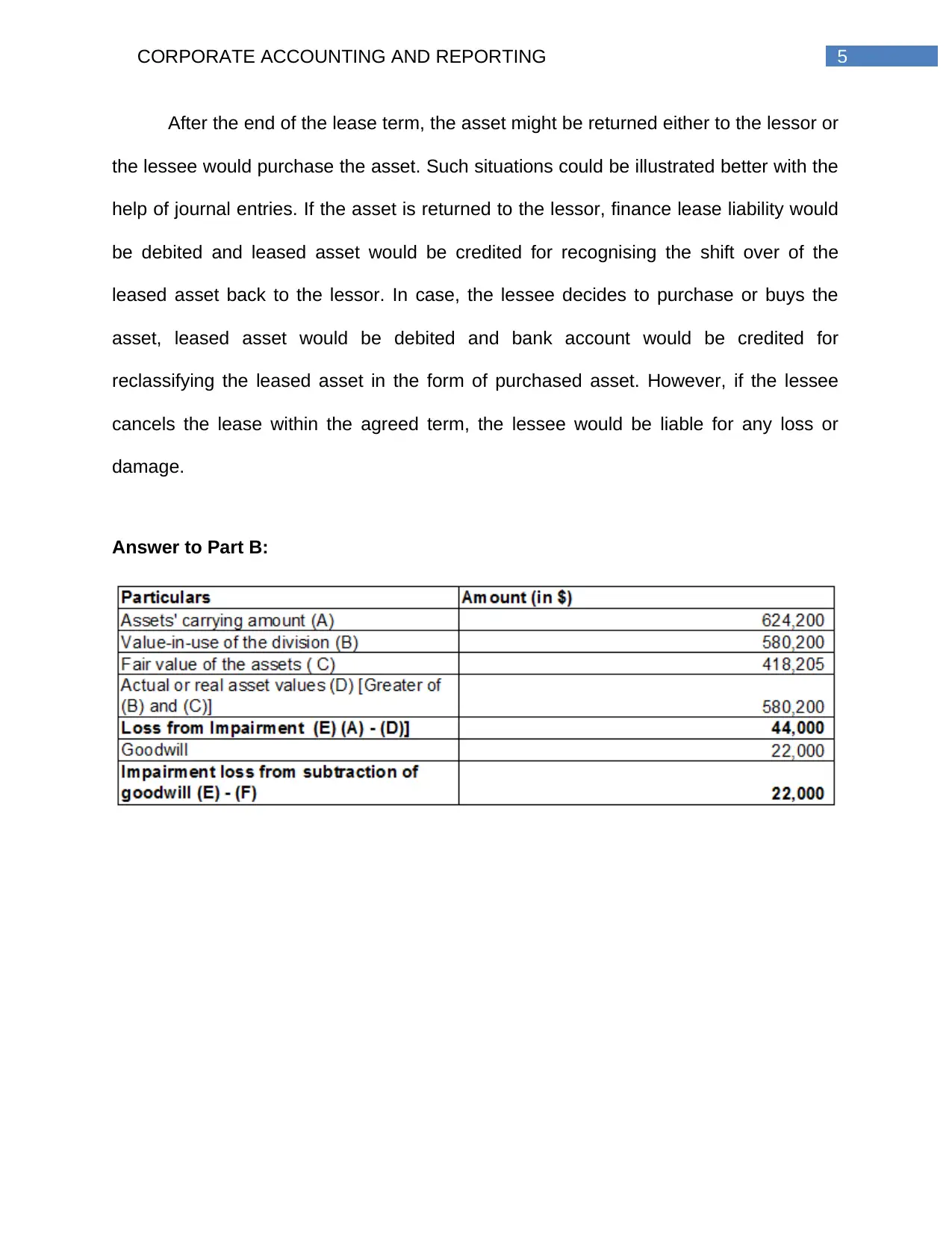
5CORPORATE ACCOUNTING AND REPORTING
After the end of the lease term, the asset might be returned either to the lessor or
the lessee would purchase the asset. Such situations could be illustrated better with the
help of journal entries. If the asset is returned to the lessor, finance lease liability would
be debited and leased asset would be credited for recognising the shift over of the
leased asset back to the lessor. In case, the lessee decides to purchase or buys the
asset, leased asset would be debited and bank account would be credited for
reclassifying the leased asset in the form of purchased asset. However, if the lessee
cancels the lease within the agreed term, the lessee would be liable for any loss or
damage.
Answer to Part B:
After the end of the lease term, the asset might be returned either to the lessor or
the lessee would purchase the asset. Such situations could be illustrated better with the
help of journal entries. If the asset is returned to the lessor, finance lease liability would
be debited and leased asset would be credited for recognising the shift over of the
leased asset back to the lessor. In case, the lessee decides to purchase or buys the
asset, leased asset would be debited and bank account would be credited for
reclassifying the leased asset in the form of purchased asset. However, if the lessee
cancels the lease within the agreed term, the lessee would be liable for any loss or
damage.
Answer to Part B:
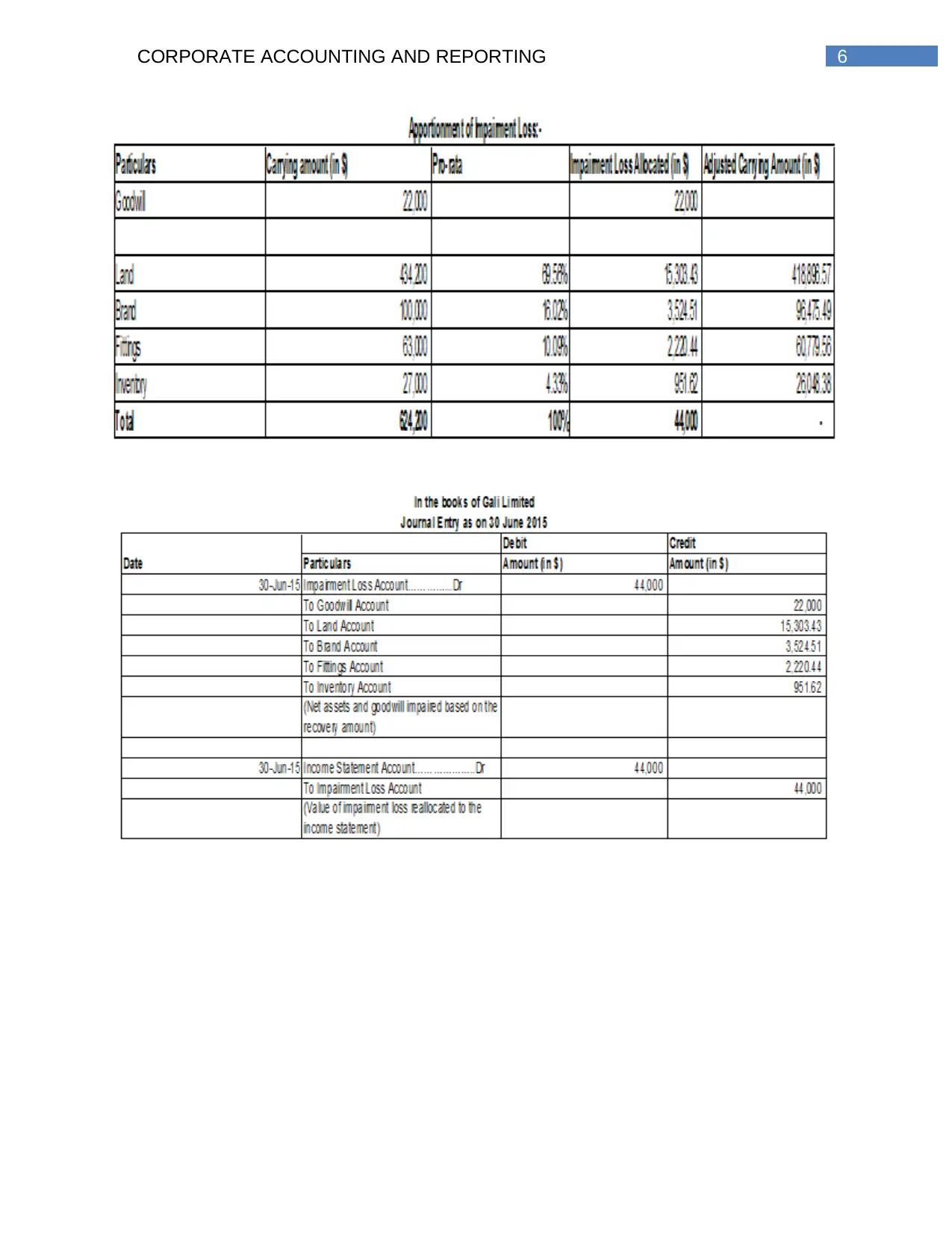
6CORPORATE ACCOUNTING AND REPORTING
Paraphrase This Document
Need a fresh take? Get an instant paraphrase of this document with our AI Paraphraser
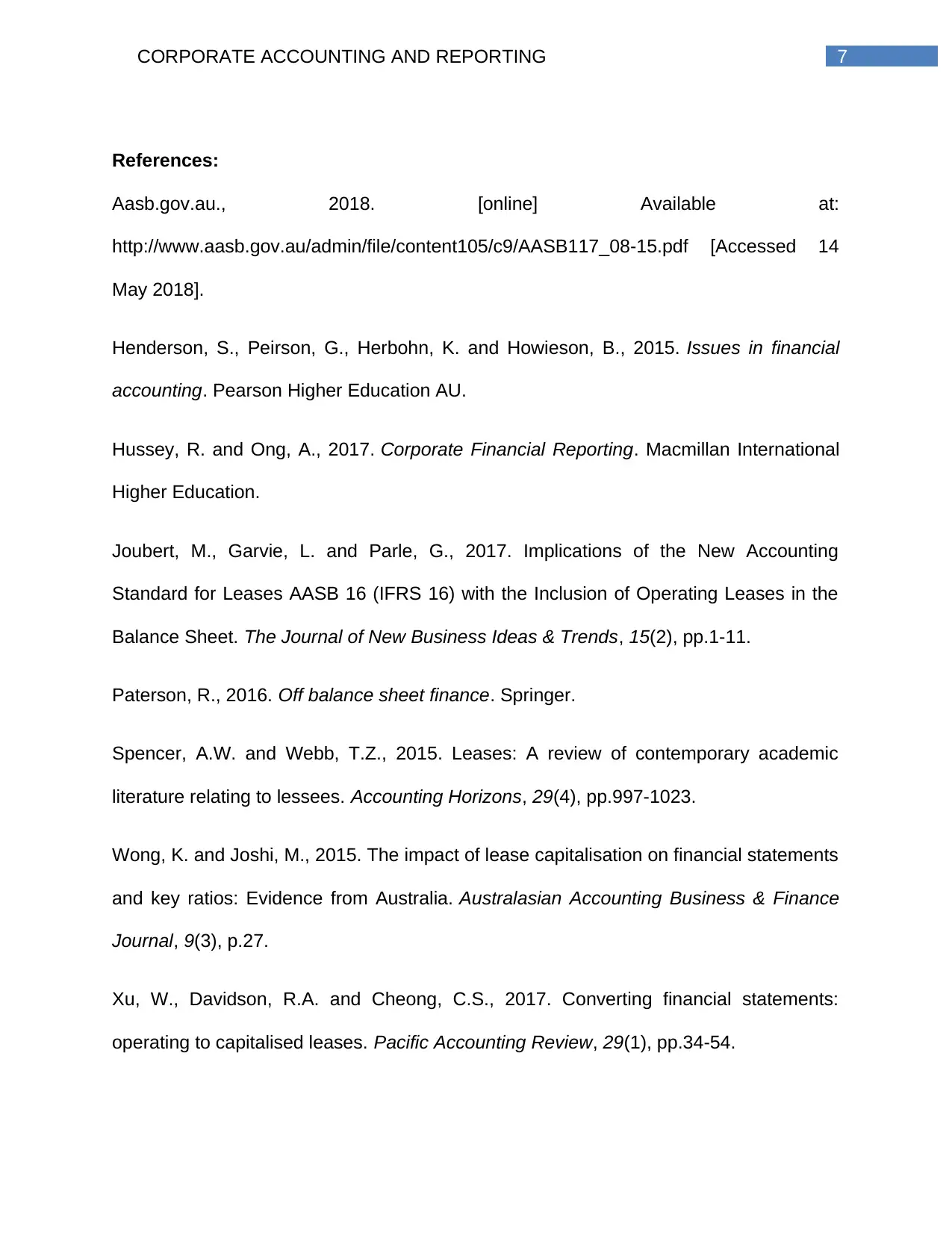
7CORPORATE ACCOUNTING AND REPORTING
References:
Aasb.gov.au., 2018. [online] Available at:
http://www.aasb.gov.au/admin/file/content105/c9/AASB117_08-15.pdf [Accessed 14
May 2018].
Henderson, S., Peirson, G., Herbohn, K. and Howieson, B., 2015. Issues in financial
accounting. Pearson Higher Education AU.
Hussey, R. and Ong, A., 2017. Corporate Financial Reporting. Macmillan International
Higher Education.
Joubert, M., Garvie, L. and Parle, G., 2017. Implications of the New Accounting
Standard for Leases AASB 16 (IFRS 16) with the Inclusion of Operating Leases in the
Balance Sheet. The Journal of New Business Ideas & Trends, 15(2), pp.1-11.
Paterson, R., 2016. Off balance sheet finance. Springer.
Spencer, A.W. and Webb, T.Z., 2015. Leases: A review of contemporary academic
literature relating to lessees. Accounting Horizons, 29(4), pp.997-1023.
Wong, K. and Joshi, M., 2015. The impact of lease capitalisation on financial statements
and key ratios: Evidence from Australia. Australasian Accounting Business & Finance
Journal, 9(3), p.27.
Xu, W., Davidson, R.A. and Cheong, C.S., 2017. Converting financial statements:
operating to capitalised leases. Pacific Accounting Review, 29(1), pp.34-54.
References:
Aasb.gov.au., 2018. [online] Available at:
http://www.aasb.gov.au/admin/file/content105/c9/AASB117_08-15.pdf [Accessed 14
May 2018].
Henderson, S., Peirson, G., Herbohn, K. and Howieson, B., 2015. Issues in financial
accounting. Pearson Higher Education AU.
Hussey, R. and Ong, A., 2017. Corporate Financial Reporting. Macmillan International
Higher Education.
Joubert, M., Garvie, L. and Parle, G., 2017. Implications of the New Accounting
Standard for Leases AASB 16 (IFRS 16) with the Inclusion of Operating Leases in the
Balance Sheet. The Journal of New Business Ideas & Trends, 15(2), pp.1-11.
Paterson, R., 2016. Off balance sheet finance. Springer.
Spencer, A.W. and Webb, T.Z., 2015. Leases: A review of contemporary academic
literature relating to lessees. Accounting Horizons, 29(4), pp.997-1023.
Wong, K. and Joshi, M., 2015. The impact of lease capitalisation on financial statements
and key ratios: Evidence from Australia. Australasian Accounting Business & Finance
Journal, 9(3), p.27.
Xu, W., Davidson, R.A. and Cheong, C.S., 2017. Converting financial statements:
operating to capitalised leases. Pacific Accounting Review, 29(1), pp.34-54.
1 out of 8
Related Documents
Your All-in-One AI-Powered Toolkit for Academic Success.
+13062052269
info@desklib.com
Available 24*7 on WhatsApp / Email
![[object Object]](/_next/static/media/star-bottom.7253800d.svg)
Unlock your academic potential
© 2024 | Zucol Services PVT LTD | All rights reserved.




